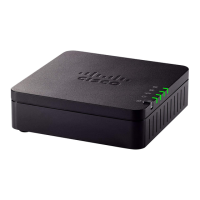Hook Flash Events
The ATA signals hook flash events to the proxy during a connected call. This feature can be used to provide
advanced mid-call services with third-party-call control.
•
Depending on your service provider, you may need to disable Call Waiting Service, Three Way
Conference Service, or Three Way Call Service. These three features could prevent the signaling of a
hook flash event to the softswitch. You can configure these settings in the Supplementary Service
Subscription section of the Line 1 and Line 2 Settings (PHONE 1 and PHONE 2) page.
•
The Hook Flash setting determines the time period required for hook flash detection. It is in the Control
Timer Values section of the SIP page.
Configurable Dial Plan with Interdigit Timers
The ATA has three configurable interdigit timers:
• The initial timeout—signals that a phone is taken off hook.
• A long timeout—signals the end of a dialed string.
• A short timeout—signals that more digits are expected.
Polarity Control
The ATA allows the polarity to be set when a call is connected and when a call is disconnected. This feature
is required to support some pay phone system and answering machines. You can configure these settings in
the FXS Port Polarity Configuration section of the Line 1 and Line 2 Settings (PHONE 1 and PHONE 2)
page.
Calling Party Control
Calling Party Control (CPC) momentarily removes the voltage between the tip and the ring signals, signaling
that the calling party has hung up. This feature is useful for auto-answer equipment. You can configure these
settings in the Control Timer Values section of the Regional page.
Encryption of SIP Messages using SIP over TLS
You can enable SIP over Transport Layer Security (TLS) to encrypt the SIP messages between the service
provider and your business. SIP over TLS relies on the TLS protocol to encrypt the signaling messages. You
can configure the SIP Transport parameter in the SIP Settings section of the Line 1 and Line 2 Settings
(PHONE 1 and PHONE 2) page.
Secure Calling Using SRTP
Voice packets are encrypted by using Secure Real-Time Transport Protocol (SRTP). This function is
implemented on a standards basis (RFC4568). Secure call service (Secure Call Serv) is enabled by default. It
is located in the Supplementary Service Subscription section of the Line 1 and Line 2 Settings (PHONE 1
and PHONE 2) page. When this service is enabled, you can activate secure calling by pressing the star (*)
key before dialing a phone number. You can also enable the Secure Call Setting to encrypt all calls from a
phone.
Cisco ATA 191 and ATA 192 Analog Telephone Adapter Administration Guide for Multiplatform Firmware
9
Get Started
Other ATA Voice Quality Features

